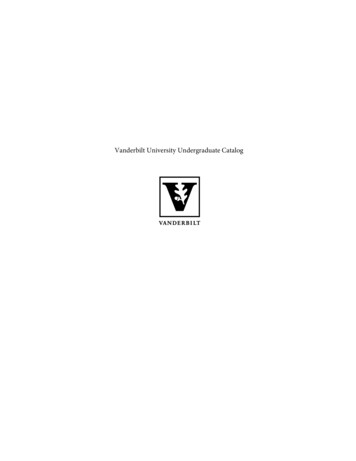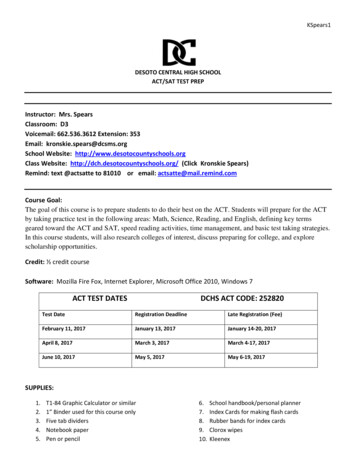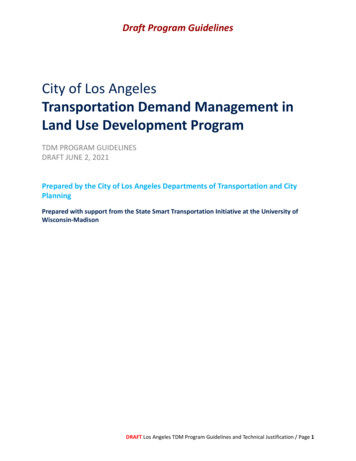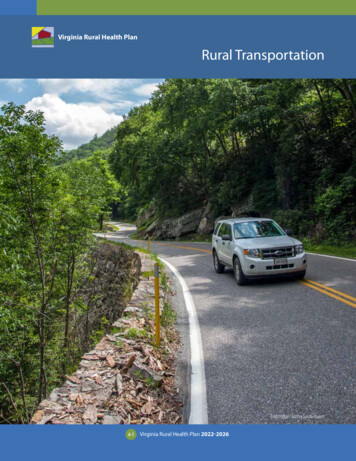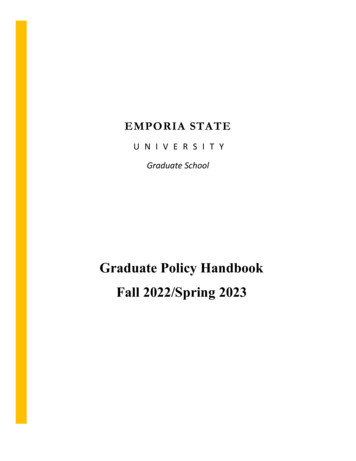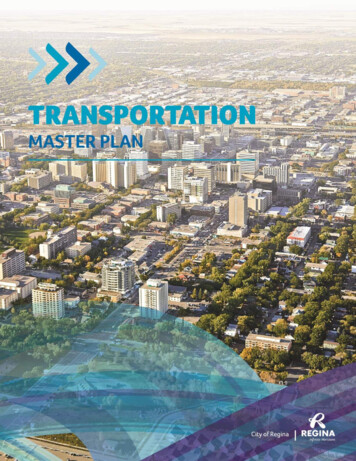
Transcription
Transportation Master PlanApril 2017i
City of Regina PolicyTitleVersionPolicyTracking #Link to theOfficialCommunityPlanTransportation Master Plan (TMP)Version 2.1, April 20172017-1-CPDThis master plan provides further policy direction on the following Official Community PlanGoals:Support Regional Growth - Support a more sustainable and beneficial approach to growthwithin the region through collaborative regional planning and service delivery.Transportation - Support regional economic growth through an effective and efficienttransportation system.Sustainable Transportation Choices - Offer a range of year-round sustainabletransportation choices for all, including a complete streets framework.Public Transit - Elevate the role of public transit.Integrated Transportation and Land Use Planning - Integrate transportation and landuse planning in order to better facilitate walking, cycling, and transit trips.Road Network Capacity - Optimize road network capacity.Active Transportation - Promote active transportation for healthier communities.Safe and Efficient Infrastructure - Meet regulatory requirements and industry bestpractices for design, construction and operation of infrastructure.Asset Management and Service Levels - Ensure infrastructure decisions result in longterm sustainability.Planned Infrastructure for Growth – The infrastructure needed for growth will be plannedfrom a long term perspective.Infrastructure Staging - Build infrastructure in a sequential and coordinated manner.Complete Neighbourhoods - Enable the development of complete neighbourhoods.Safety and Urban Planning - Improve overall health of the public through urban planning.Health and Environmental Impacts - Minimize social and environmental impacts andimprove the health and safety of the city and uledReviewThe TMP provides further policy direction on City of Regina services such as Transit,Parking, Roads, and Parks.Director of Planning DepartmentThe TMP is scheduled for a full review every 5 years, with the first review occurring in 2022.Transportation Master PlanApril 2017ii
The City of Regina acknowledges the contributions of the IBI Group to the developmentof the Transportation Master Plan:The City of Regina would like to recognize the many stakeholders and members of thepublic who shared their thoughts to shape our city through the process of developingthis plan.The City of Regina would also like to thank the participants who helped prepare theTransportation Master Plan. This document is a testament to our employees’ hard workand commitment.iiiApril 2017Transportation Master Plan
Executive SummaryIn 2013 City Council approved Design Regina, the Official Community Plan Bylaw No.2013-48 (OCP). Aligning with the OCP Community Priority “Creating Better, and MoreActive Ways of Getting Around,” the Transportation Master Plan (TMP) is acomprehensive and multi-modal transportation policy and planning document. The TMPalso delivers more detailed policy direction on the five Design Regina TransportationPolicy Goals found in Section D3 of the OCP.In developing the TMP, the policies, actions and future transportation networks arestructured around seven Transportation Directions (Directions). These Directions weredeveloped in consultation with the community, approved by Council in 2012, andencompass all modes and roles of transportation. The Directions were based on guidingprinciples of accessibility, environmental protection, social equity, technology, fit for fourseasons and safety. Since 2012 the TMP has been adjusted to conform to the city’snew master plan template while leaving the previously approved directions, goals,policies and actions in place.The Directions highlight the community priorities to provide Regina residents with achoice of travel mode that complements travel by private vehicle. New and existingneighbourhoods will be tailored to make it easier to get around by incorporating transitas a competitive travel choice and providing a network of sidewalks, multi-use pathwaysand bikeways to promote healthier communities. The city will invest in affordable anddurable infrastructure by maximizing the life span and optimizing the road network toreflect community context and modern design standards. Also emphasized is theefficient and effective movement of goods and people in support of economic growth.From the seven Directions, this document consists of 33 Goals, 216 TransportationPolicies and Recommended Actions, Transportation Network Maps for all modes oftravel, and a Complete Streets Framework.By developing a transportation system that balances all modes and promotessustainable transportation choices, the City of Regina can promote the development ofconnected and complete neighbourhoods and create a healthy and vibrant city for allresidents. Improving transportation choices for all residents requires shifting how thecity invests in and manages transportation infrastructure now and in the future.Over the next 25 years, the City of Regina will need to provide adequate funding toaccommodate population growth by improving and expanding multi-modaltransportation networks to meet the Plan’s goals. The TMP provides policy direction toinform decisions that are made by Administration and Council as part of the definedbudget process. The TMP is not a commitment for future investment, however, theexpenditures in this plan are higher than the current spend. Transportation investmentsthat are recommended to meet the Directions and Goals of this plan will be approvedonly after Council approves the budget in any given year.Transportation Master PlanApril 2017iv
vApril 2017Transportation Master Plan
Table of ContentsCity of Regina Policy iiExecutive Summary ivIntroduction 1Current Reality 8Future Vision 15D1 Offer a Range of Sustainable Transportation Choices for All 21D2 Integrate Transportation and Land use Planning 27D3 Elevate the Role of Public Transit 35D4 Promote Active Transportation for Healthier Communities 41D5 Optimize Road Network Capacity 47D6 Invest in an Affordable and Durable System 53D7 Support a Prosperous Regina and Region 59Implementation Plan 62Appendix A: MapsAppendix B: Transportation Capital InvestmentsAppendix C: Summary of TMP Policies and ActionsAppendix D: Framework for Complete StreetsAppendix E: DefinitionsTransportation Master PlanApril 2017vi
IntroductionPurposeIn recent years, Regina has experienced unprecedented growth attracting newresidents and new jobs. Supporting this growth and change requires planning thetransportation system to allow all residents access to housing, employment,community amenities, and entertainment opportunities year-round.The community has said they want a transportation system that is people-focusedand supports users of all ages, abilities, and modes of transportation.The TMP provides direction on how to balance investment in transportationinfrastructure and provide all residents with improved transportation choices.Maximizing the capacity of existing infrastructure will help to meet the needs of agrowing population. Improving transit service with express routes and providing safeand attractive walking and cycling environments will connect more people toemployment and neighbourhood opportunities. Considering the long term costs oftransportation infrastructure will ensure that investment in new roads and sidewalks isbalanced with timely maintenance of existing assets. Shifting the way transportationinfrastructure is designed and operated will support the development of completestreets that promote the safety and accessibility of residents of all ages and abilities.Improving transportation choices also requires an adjustment in expectations of howresidents move by balancing the level of service on roadways with what the city canafford to invest and maintain over the long term.ScopeThe City of Regina defines a master plan as a long term plan of up to 25 years thatdescribes citywide outcomes for a service or group of services and should have astrong link to the Official Community Plan. The TMP is a comprehensive and multimodal transportation policy and planning document for all modes of transportation,walking, cycling, transit and vehicles, that encompasses the investment and operationof transportation infrastructure.The TMP was developed as part of the Design Regina process and is consistent withthe objectives and policies of the OCP, as a whole, and delivers more detaileddirection on the following goals of Section D3:1April 2017Transportation Master Plan
OCP Transportation Goal 1 - Sustainable Transportation Choices:Offer a range of year-round sustainable transportation choices for all, including acomplete streets framework (Appendix D).OCP Transportation Goal 2 - Public Transit:Elevate the role of public transit.OCP Transportation Goal 3 - Integrated Transportation and Land Use Planning:Integrate transportation and land use planning in order to facilitate better walking,cycling and transit trips.OCP Transportation Goal 4 - Road Network Capacity:Optimize road network capacity.OCP Transportation Goal 5 - Active Transportation:Promote active transportation for healthier communities.Process and EngagementDesign Regina: Official Community Plan Bylaw No. 2013-48In 2013, Regina adopted a new OCP which directs how the city will grow and changeover the next 25 years. The OCP is the highest level policy document at the City ofRegina; all other policies, strategies, and plans must align with the OCP.As per OCP Policy 5.1, the TMP will be the guiding document for transportation policyand planning. Changes to the TMP may trigger the need for OCP policy and mapamendments and vice versa. In the near term, updates to city policies and bylaws willbe undertaken to support the TMP goals and policies.A Community Priority developed as part of the OCP is to “Create Better, More ActiveWays of Getting Around”. While the TMP aligns closely with this priority, it is informedby all OCP Community Priorities including “Develop Complete Neighbourhoods”,“Achieve Long Term Financial Viability”, and “Optimize Regional Cooperation”.The OCP Growth Plan will accommodate population growth in the city to 300,000people. Growth in the city will strengthen existing neighbourhoods, centres, and urbancorridors while also supporting growth in new neighbourhoods. To supportintensification, 30 per cent of population growth will be directed to existing urbanareas including 10,000 new residents within the City Centre. By focusingtransportation planning on improving transportation options, residents living in existingTransportation Master PlanApril 20172
and new neighbourhoods will be able to meet their needs using a range oftransportation choices.Previous City of Regina Transportation Master PlanRegina’s last major Transportation Plan was developed in 1991 and primarily focusedon the road network and transit. Although it was updated in 2001, a new multi-modalplan which reflects modern transportation planning best-practices and the renewedvision for the city in Design Regina was needed.Regina Transit Investment PlanIn 2009, Regina Transit completed a Transit Investment Plan (TIP) to identify shortand long term transit improvements to respond to changing customer demand and togrow transit ridership. The preferred service alternative, which will guide transitnetwork planning in Regina, is known as the “top-down” approach which focuses ondeveloping direct transit services that connect the Downtown to activity hubs on theperiphery of the city along major corridors. The TMP builds on the transit supportivepractices recommended in the TIP including providing transit service that connectsneighbourhoods and destinations, increased reliability of transit service throughpriority measures, improved customer information and fare policies that encouragetransit use, and developing a positive image of transit in the city.Downtown Transportation StudyIn 2014, the City of Regina completed the Downtown Transportation Study (DTS),which examined transportation issues and identified opportunities to improveconditions for all users (pedestrians, cyclists, transit riders, vehicles and deliveryvehicles) in the downtown. The TMP supports the recommendations from the DTSwithin larger citywide goals and policies.Plan DevelopmentThe process of developing the TMP began in 2012 and was fully integrated with theOCP planning and consultation process. The TMP project team worked closely withthe OCP project team during the development of the OCP. This involved workingtogether to participate in OCP development activities, developing transportationrelated goals and policies, and assessing growth options from a transportationperspective.Guided by the OCP’s Community Priorities, Transportation Directions (Directions)were developed to inform goals and policies included in both the OCP and the TMP.The Directions were presented to the public for feedback and to understand which3April 2017Transportation Master Plan
Directions represented their transportation priorities. Draft goals, policies, and actionswere developed for the TMP along with network maps for all modes. Working with thepublic, stakeholder groups, and city staff, these policies and networks have beenfinalized.Public EngagementFigure 1: Plan Development ProcessThroughout the development of the TMP, there was a high level of public engagementwhich provided a variety of opportunities and methods for residents to provide input,suggestions, and feedback. Public input was sought at different stages of plandevelopment including the development of the Directions, draft goals and policies, aswell as during the development of the draft networks.Public Open Houses:A number of public open house events were held throughout the TMP planningprocess. An initial series of open house events were held in May 2012 as part of theTMP launch. The public identified priorities they wanted to see reflected within theTMP and provided feedback on the draft Directions. The next series of open houseevents, held in October 2013, presented the draft goals and transportation networksTransportation Master PlanApril 20174
to the public. Residents were asked to provide input and feedback on policies andactions they felt would help to achieve the Directions and goals. A final open housewas held in April 2014 to present and seek feedback on the refined goals, policiesand networks.Online Engagement:In conjunction with the public open houses, residents were encouraged to providefeedback on the draft Directions, goals, and networks using online surveys. Thesurveys were publicized on the TMP section of the Design Regina website andresponses were encouraged through the Design Regina email list.Stakeholder Meetings:Meetings with stakeholder groups were held as the plan was developed to allow forfocused discussions around particular areas of interest.5April 2017Transportation Master Plan
The Community Working Group was comprised of representatives of variouscommunity interests and included representatives from advocacy groups, communityorganizations, school boards, and businesses.The Multi-Modal Working Group included representatives from mode-specificorganizations, such as transit, cycling, care share, rail companies, and emergencyservices.The Regional Stakeholders included representatives from government agenciesaround the Regina region, including provincial departments and surrounding ruralmunicipalities.The homebuilder and development industry representatives included members fromthe Regina & Region Home Builders’ Association.Meetings were also held with additional stakeholder groups such as representativesfrom the Knowledge Corridor including the University of Regina and SaskatchewanPolytechnic.Multi-modal WorkshopsMulti-modal workshops were held as part of the engagement program for the TMP.The primary purpose of the workshops was to provide a more intensive look at thechallenges and opportunities for three alternative modes of travel: transit, walking,and cycling. The workshops included presentations of current conditions and bestpractices followed by breakout sessions (transit) or off-site tours (pedestrian andcycling). Attendees at these workshops included city staff, members of the projectteam, representatives from community and advocacy groups, and the general public.Internal Staff ConsultationThrough the planning process, there was a high level of consultation with internal staffto ensure that the Directions, goals and policies would be feasible and respond tolocal conditions. Staff members from a variety of areas were represented andprovided valuable feedback during development of the TMP.Role of the MunicipalityThe city’s role is to provide, operate and maintain transportation infrastructure for allmodes of transportation including active modes, transit, personal vehicles andmovement of goods. The city is a partner, stakeholder, and advocate for regionaltransportation issues. Some things within the city’s control include road right-of-ways(ROWs), street infrastructure and land use. Safety, financial and environmentalregulatory compliance, and sustainability are key aspects that are considered intransportation decision making.Transportation Master PlanApril 20176
Guiding PrinciplesThe Guiding Principles represent the broad objectives integrated throughout the TMP.They should continue to be considered during transportation planning and operations.AccessibilityThe TMP will continue advancing towards an inclusive, universallyaccessible transportation system that is responsive to changingdemographics, mobility needs, and best practices in universal and barrierfree design.Environmental ProtectionImprovements to the environmental performance of the transportationsystem through travel reduction, modal shift, alternative fuels, andemissions reduction will be identified to help conserve resources andpreserve the environment for future generations.Social EquityTransportation strategies will aim to promote equitable access to mobility,develop safe and healthy communities, and maximize opportunities for allresidents in Regina.TechnologyTransportation in Regina will take advantage of advances and innovationsin technology to improve the efficiency of the network and improve travelerinformation. Open data would encourage local solutions to localchallenges.Fit for Four SeasonsThe TMP recognizes that Regina is a city with four distinct seasons.Policies and strategies must consider the challenges of, but also theopportunities provided by, the climate.SafetyEnsuring the safe movement of people and goods regardless of travelmode is paramount within the TMP.7April 2017Transportation Master Plan
Current RealityHow We MoveCurrently, most trips in Regina are made by private vehicles. Figure 2 depicts the tripsby mode for the various modes of travel in Regina. A background study found that 85per cent of all peak period trips are made by car, of which 67 per cent are made insingle-occupant vehicles (SOVs); 18 per cent of all peak period trips are made as anauto passenger1. Active modes account for approximately eight per cent of all peakperiod trips, while transit accounts for only three per cent of all peak period trips,which is low compared to similar Canadian cities2.Figure 2: Current Mode Share Percentages, a.m. Peak PeriodThe majority of trips are made to access employment and schools during the morningpeak period, depicted in Figure 3. Morning peak period travel is largely toward theCity Centre, however, there are a number of longer trips, including from the northwestacross the city and north/south trips made through the middle of the city.1City of Regina Household Travel Survey. 2009.2Transportation Association of Canada (TAC). 2016. Urban Transportation Indicators - Fifth SurveyTransportation Master PlanApril 20178
Figure 3: Trip Flows Between Traffic Zones, a.m. Peak Period9April 2017Transportation Master Plan
Some peak period travel flows to the City Centre have transit mode shares betweenfive and 10 per cent and trips to the University have transit mode shares of 15 percent or more.3.As the city grows and changes, travel patterns also change. Transit is increasinglybecoming an attractive travel choice as the cost of driving and congestion increases.In 2013, improvements to transit service, including the introduction of more expressand direct routes, as well as scheduling changes, were successful in increasingcitywide transit ridership by 13.8 per cent within the first months of implementation.Overall, Regina’s transportation infrastructure can be currently defined by the amountof assets which make up the vehicular, active and transit modes it serves. Thisinfrastructure impacts the distance and time travelled to and from destinations withinthe city. As the city continues to grow, this plan will provide the guidance necessary tooffer increased transportation choices for residents in a sustainable manner.Figure 4: Regina’s Transportation InfrastructureSidewalks:Multi-use Pathway:On-street Bike Lanes:Transit Routes:Bus Stops:Transit Shelters:Paved Roads:Paved Alleys:1,475 km41 km21 km2113632551135 km173 kmSignalized Intersections: 202Pedestrian Half Signals:93There may be a degree of random sampling bias in these numbers due to the lower survey sample for these flows.Transportation Master PlanApril 201710
Figure 5: Average Travel Time for Regina, 2012Figure 6: Average Peak Period Trip Length, a.m. Peak Period11April 2017Transportation Master Plan
How We InvestHistorically, a large portion of Regina’s transportation budget has been dedicated toroadways including street and bridge infrastructure renewal, traffic control and safety,streetscape development, roadway improvements and safety improvements. Pastinvestment in transit was largely to fund the purchase of replacement buses andvehicles, facilities such as shelters and fare boxes, and general office equipment.Sidewalk construction and repair is included within the roadways budget andconstruction of pathways and bike lanes are funded through specific annual budgetrequests. There is currently no dedicated funding for the construction of activetransportation facilities. Existing active transportation expenditures consist primarily ofasphalt recapping of multi-use pathways.The following graphs depict a breakdown of funds allocated to the different modes forboth capital and operating expenditures. This section highlights what the city hashistorically invested in transportation.Figure 7 depicts the average annual capital investment, differentiated by mode, forthe period 2012 to 2016. Historically, 82 per cent of funds have been allocated toroadways capital programs which include, among other things, investments in newroadways, road widenings and intersection upgrades. 15 per cent of funds historicallyhave been allocated to transit related projects such as fleet expansion andreplacement. Active transportation generally includes investments in on-street bicyclelanes, multi-use pathways and infill sidewalks. Multi-modal expenditures can beattributed to the development of specific programs and policies such as the OCP,TMP and the Downtown Transportation and Transit Study.Figure 7: Transportation Capital Budget Allocation (2012-2016)Average AnnualCategoryCapital InvestmentTransportation Master PlanRoadways 35.5MTransit 6.4MActive Transportation 0.7MMulti-modal 0.6MTotal Investment 43.2MApril 201712
Figure 8: Transportation Operating Budget Allocation (2012-2016)Average AnnualCategoryOperating InvestmentRoadways 31.3MTransit 30.6MActive Transportation 4.2MTotal Investment 66.1MFigure 8 depicts the average annual operating investment, differentiated by mode forthe period 2012 to 2016. Operational investments associated with activetransportation includes the recapping of asphalt on multi-use pathways, winter- andconcrete maintenance of sidewalks as well as the maintenance of on-street bikeways.What We HeardOverall, feedback received through the open houses, stakeholder meetings, andonline engagement was constructive. Attendees provided useful considerations,ideas, and suggestions for the project team as it developed the draft policies andactions for the TMP. Some of the key themes of feedback are summarized below.Better TransitAttendees identified better transit as a priority for the TMP. Improving transit servicewith more direct and express routes, expanded hours, and more frequent servicewould encourage more people to use the system. There were continuing concernswith transit operations within downtown Regina and the conflicts with other traffic andimpacts on surrounding businesses.However, most attendees saw transit as playing an important role for travel to andfrom downtown. Other important policies and strategies were also raised, such assidewalk connections to transit stops, accessibility on transit, and improved brandingand customer information.13April 2017Transportation Master Plan
Address Winter TravelGreater enforcement of snow removal on sidewalks, especially in core areas of thecity and near bus stops, was seen as a priority. Other suggestions related to wintertransportation included clearing pathways of snow in the winter, providing heatedtransit shelters, and better communication of snow removal policies.Expand the cycling networkMost attendees appreciated the inclusion of a comprehensive network for cycling,particularly, the definition of a priority cycling network for near-term implementation.Improving local connections to citywide pathway networks was defined as a priority,as are routes to major destinations such as the downtown and the university.Significant input was received from the public and stakeholder groups that help refinethe draft cycling network.Manage roadway congestionPeople travelling around Regina by car were concerned that travel times areincreasing as congestion and traffic volumes grow. Bottlenecks and missing links inthe roadway network are cited as key concerns. Major regional projects, such as theRegina Bypass are seen as imperative projects to help improve traffic flow.Improved accessibilityAccessibility of the transportation network was a high priority for many in Regina andrecognized to be a pressing priority today and in the future as our population ages.Providing travel choices for persons with disabilities, which includes an accessibleconventional transit system, paratransit, and a barrier-free built environment, isimportant. Short term initiatives, such as accessible pedestrian signals, more andbetter designed curb ramps, and sidewalk maintenance were also suggested.Timely maintenance and renewalEnsuring that our roadways, structures, sidewalks, and vehicles are well maintainedwas identified as a priority. In some instances, maintenance was seen as a higherpriority than expanding the network to accommodate growth. Common feedbackincluded better monitoring and reporting of infrastructure, quicker responses tocomplaints, and a clear system for prioritizing repairs.Transportation Master PlanApril 201714
Future VisionThe TMP Guiding Principles and Directions reflect the city’s collective vision forRegina’s transportation system.Transportation DirectionsThe TMP is structured around seven Directions which are the guiding statements forthe development of the plan’s goals, policies, strategies and transportation networks.The Directions were developed in consultation with the community and encompass allmodes and roles of transportation in the city such as promoting a healthy, vibrant city,improving modal choice, fostering economic prosperity, and creating a sustainabletransportation network. The Directions also support the Community Prioritiesidentified in the OCP.Direction 1: Offer a Range of Sustainable Transportation Choices for All.Regina’s residents will have a choice of travel modes that complement access byprivate vehicle. Strategies around transit, walking, cycling, and carpooling, combinedwith programs that educate and maximize existing transportation infrastructure, willoffer travel choices that are easy, affordable, sustainable and more enjoyable for allusers.Direction 2: Integrate Transportation and Land Use Planning.By planning land use and transportation concurrently, Regina can tailor new andexisting neighbourhoods to make it easier to get around by all modes. CompleteStreets, which feature a range of transportation modes, will help support vibrant,active and Complete Neighbourhoods.Direction 3: Elevate the Role of Public Transit.Public transit will play a pivotal role in Regina’s transportation future by becoming acompetitive travel choice tightly integrated with our neighbourhoods. Transit will worktoward becoming a more accessible system with frequent and reliable service,extended hours, and enhanced customer amenities. The identification of primarytransit corridors suitable for express routes will help shape land use.Direction 4: Promote Active Transportation for Healthier Communities.Active modes such as walking, rolling, and cycling will be integral for day-to-day traveland for recreation. Pathways and bikeways will be extended to provide a connectednetwork of comfortable and safe active corridors between key destinations.15April 2017Transportation Master Plan
Educational programs will promote mutual respect among all road users andadvo
on the road network and transit. Although it was updated in 2001, a new multi-modal plan which reflects modern transportation planning best-practices and the renewed vision for the city in Design Regina was needed. Regina Transit Investment Plan In 2009, Regina Transit completed a Transit Investment Plan (TIP) to identify short



